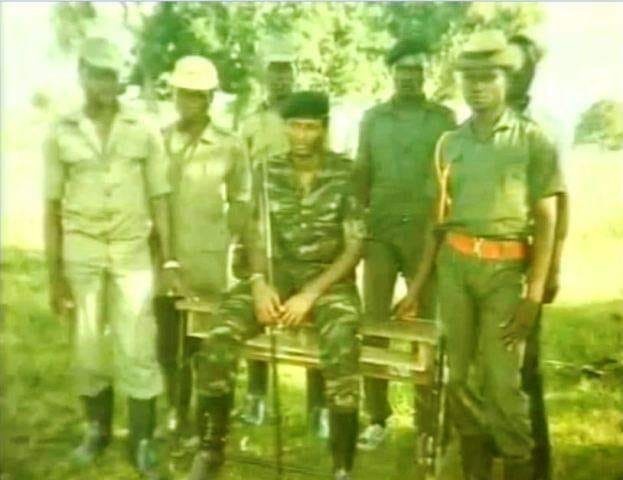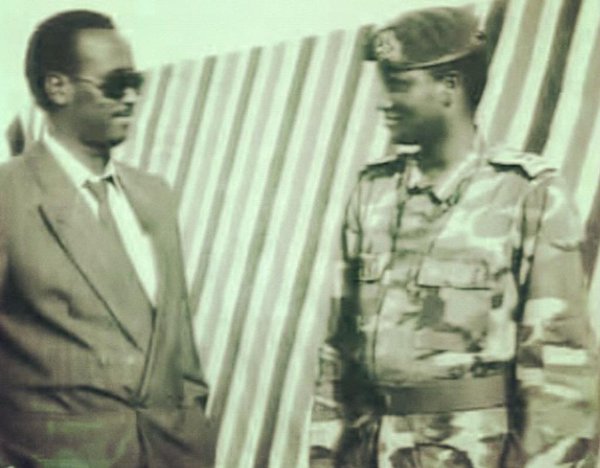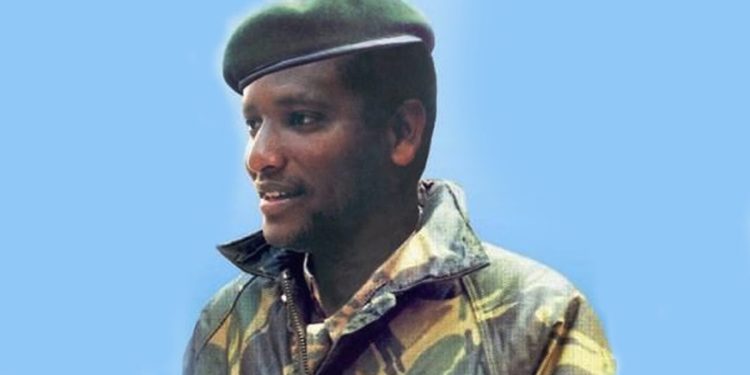BY FAUSTIN MUGABE
He was born Gisa and christened Fred. But very few have any inkling that his popular nom de guerre, Rwigyema, was given to him by guerilla leader Yoweri Museveni, soon after they met in 1976.
Gisa was recruited into rebel ranks of the fledgling Front for National Salvation (Fronasa), a movement led by Museveni to fight the murderous regime of late President Idi Amin, who ruled Uganda with an iron fist between 1970 and 1979.
The fictitious name, Rwigyema, stuck on and eclipsed Gisa throughout Fred’s combat days from 1976 to 1990.
Rookie Fred Gisa
Rwigyema’s military journey begins in 1976, when Kahinda Otafiire, then a civil servant in the Uganda government, drafted him, Chefe Ali, and their teacher Ivan Koreta from Mbarara High School into Fronasa. From Ankole in western Uganda, the recruits were infiltrated into Kenya, then Tanzania, and onto Mozambique, where they were drilled into guerrilla warfare for two years.
But 30 years later today, since Fred died, his name Rwigyema, still rings loud despite no public monument neither in remembrance of his honour in both Rwanda, his country of origin, nor Uganda, his adopted country.

Nevertheless, the name Rwigyema will, perhaps, keep ringing for many years for his military exploits since his death on the battlefield on October 2, 1990. Rwigyema was killed on the front line, about two miles inside Rwanda, off the border with Uganda. And perhaps Rwigyema would have preferred it that way. He was never a public attention seeker and always passed incognito, according to those who closely interacted with him.
When he was killed, Rwigyema was at the head of deserting Rwandan fighters in Uganda’s National Resistance Army (NRA), which had toppled the Tito Okello military junta that had in turn overthrown the Milton Obote II regime in 1985.
Fred Gisa, alias Rwigyema
But how did Fred Gisa, alias Rwigyema, win his military celebrity status with a concealed identity?
When Museveni got to know that Fred Gisa was a Munyarwanda, he gave him an assumed name, Rwigyema, which readily stuck, just like other false names of combatants such as Chefe Ali, and Salim Saleh.
On page 277 in his book, Sowing the mustard seed (2nd Edition), President Museveni revisits why he gave Gisa the alias Rwigyema, after a brave Tutsi fighter in Democratic Republic of Congo in the 1960s.
Museveni writes: “In our effort of recruiting fighters to train in Mozambique, in the middle of 1976, I received, among others, in Nairobi, a group of three boys, recruited from Mbarara High School by Otafiire. One of these was Gisa, whom we gave the bush name of Rwigyema. I think I am the one who gave that bush name because the Cuban diplomats in Dar es Salaam had for long told me of a reliable and brave Mututsi that had stuck with Che Guevara when he was in Congo by the name of Gabriel Rwigyema.”
Writing about Gisa, the President goes on: “…I straight away realised that he was a Munyarwanda youth that had joined one of my youth groups connected to another youth known as Nasasira. Being a Munyarwanda was not, however, a problem for Fronasa, a pan-Africanist organisation. Rwigyema, therefore, was among the 28 other fighters that Frelimo helped me to train in Montepuez in northern Mozambique between 1976 and 1978.”
While in Mozambique, Rwigyema developed a special friendship with Caleb Akandwanaho, Museveni’s young brother. The friendship between Rwigyema and Salim Saleh was said to be somehow “indescribable” so much so that that the two were said to behave like Siamese twins who were only “medically separated” because of the bond that existed or glued them.
As a matter of fact, some authors believe that Rwigyema could not have left Uganda for the RPF war in Rwanda without saying “bye” to his friend, Saleh.
Coincidentally, on November 26, 1989, the two as generals in Museveni’s army, were relieved of their duties in a military reshuffle. Saleh was dropped as army commander, while Rwigyema was dropped as deputy minister of State for Defence.
Rwigyema was to go for a military course in the United States – although he “faked a believable excuse” and his commander-in-chief, Museveni bought into the lie and instead sent Paul Kagame, now Rwandan President, for the course.
On Monday October 1, 1990, a group of Banyarwanda army officers in Uganda’s national army, the National Resistance Army (NRA), led by Major General Fred Rwigyema, invaded Rwanda.
But Rwigyema was tragically killed on the second day of invasion of Rwanda by Uganda-based Rwanda Patriotic Front (RPF).
Saleh weeps for Rwigyema
A day or two after Rwigyema had died, the sad news of his death filtered back to Uganda through whispers.
It is a popular belief that among the first Ugandans to be informed was Rwigyema’s confidant, Gen Saleh. An informed source, told this reporter how Saleh reacted.
“He was devastated”, he said.

“When Saleh reached Rwigyema’s home at Muyenga Hill, an upscale suburb of Kampala, he said: “I was told Jeanette, Rwigyema’s wife, was emotionally stronger than General Saleh,” the source said.
“It was Jeanette who instead consoled Saleh. She told Saleh it was God’s will that Fred was gone; as Saleh cursed whoever had shot dead Rwigyema,” a source said.
Gen Saleh’s inconsolable grief was only returning an old favour from a fallen comrade-in-arms.
When Rwigyema cried for Saleh
Earlier, during the Luweero war, Rwigyema had also cried for Saleh when he was wounded by the enemy bullets. On February 21, 1983, one of the deadliest battles of the Luweero war was fought at Uganda National Liberation Army (UNLA) Bukalabi military detachment and Commander Saleh was one the many causalities that the National Resistance Army (NRA) rebels registered.
The enemy forces shot Saleh several times in both arms.
General Pecos Kutesa was one of the combatants who witnessed Saleh being stretchered off the battlefield to the Command Post. In his book, Uganda’s revolution 1979-1986: How I saw it, Kutesa captures the moment on page 151.
“Even Commander Fred Rwigyema broke down and wept when he saw the wounded Commander Saleh,” Kutesa writes.
But why would Museveni give a Munyarwanda youth recruit Gisa, a Tutsi army general’s name, Rwigyema?
This has its roots in the Rwanda crisis of 1959, which had forced some Banyarwanda refugees to cross into Uganda.
BACKGROUND
Rwigyema, Guevara, Kabila mix
When the Tutsi were ousted from power by the Hutu in Rwanda in the 1959 genocide, the Tutsi fighters melted away into present-day eastern DRC.
Fred Gisa was from the group of Banyarwanda refugees exiled in Uganda following the Rwanda crisis of 1959.
In 1967, Cuban legendary freedom fighter Ernesto Che Guevara found the Banyarwanda in present-day eastern DRC contemplating return to power in Kigali by military victory. The Tutsi fighters were armed by Chinese communist leader Mao Zedong (1893-1976).
The arms from China, through Mombasa port passed through Uganda to Rwanda and finally Congo. While then Kenyan President Jomo Kenyatta was in the know, Uganda’s President Milton Obote was not aware. In fact, Uganda got intelligence when the arms had crossed through Rwanda into DRC.
Meanwhile, President Obote tasked Sam Baingana, the brother of Mathew Rukikaire, who worked in the Ministry of Foreign Affairs to establish why President Kenyatta allowed the Tutsi arms from China to transit through Uganda without Uganda being informed.
In the book, My lost years in Congo, Che Guevara mentions that Tutsi fighters though living in a foreign country, were more reliable and determined to fight and win than the Congolese fighters led by Laurent Desiree Kabila, who always complained of no sugar and beef among other unnecessary needs of a revolutionary fighter.
One such reliable and brave Tutsi (Munyarwanda) in Congo was one Gabriel Rwigyema, whose name Museveni gave to Fed Gisa, a young recruit, after Museveni heard of the exploits of one Rwigyema from Cuban diplomats in Dar es Salaam.
A Chinese spy, Kao Liang, identified by the American CIA disguising as a correspondent of the New China newspaper for the East Africa region based in Tanzania, was the head of the armed intervention in Rwanda.
Liang oversaw the recruitment of Tutsi fighters from refugee camps in DRC, Uganda, Tanzania, and Burundi and infiltrated them into Congo, according to a CIA report.


